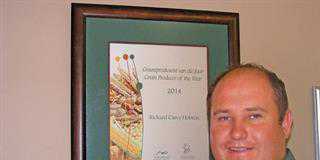
The idea of adopting ‘softer chemicals’ appeals to many crop farmers, but they are often reluctant to make the change for fear of experiencing yield decline. But Merrivale farmer Brett Frost has found that, by merging organic and conventional products, he is achieving higher yields of a healthier product, and keeping his customers and auditors happy. He has also discovered that including a green manure crop in his crop rotation has enabled his cattle and vegetables to thrive.
Frost and his business partner Troy Holmes own two farms of 16ha and 58ha, as well as leasing 100ha, in Merrivale, outside Pietermaritzburg, KwaZulu-Natal. Holmes oversees a commercial breeding herd of 125 Bonsmara cows and 90ha of open land vegetables under irrigation. These include broccoli, spinach, cauliflower and crisp lettuce; only 30ha is planted to vegetables at any one time.
Frost manages 3ha of shade-cloth tunnels, where fancy lettuce, celery, spring onion, baby cabbage and baby spinach are grown in a gravel bed hydroponic system. He also manages the packhouse and marketing for their Frosties Farm fresh produce label.
“We’ve tried to go greener where possible because of pressure from the GlobalGAP auditors and growing consumer concern about certain chemicals being linked to cancer,” he says. Frost admits he was initially sceptical of claims made by companies marketing organic or ‘green label’ products. But after using these products for the past three seasons, he is now convinced of the benefits.

Brett Frost with vegetable manager Never Mutewa.
Arsenal
Among Frost’s arsenal of green label products are the foliar feeds Thrust and Veggi-Mix, the fungicide One-Time and the pesticide Instinct from Eco-Green. He uses these in conjunction with In-Cap, a sticker/wetter/spreader. “We alternate between the foliar feeds, and spray about 4l/ha once a week in both tunnels and open fields,” he explains. “They contain all the macro and micro trace elements, which are quickly available and absorbed through the leaves to help the plants cope with stress such as heat, drought or cold.
They also contain a lot of amino acids – the building blocks of protein – and help optimise veg yields.” Yields have increased by 20% since Frost started using the foliar feeds, which more than covers the cost of the product. He harvests between 12t and 15t of broccoli a month. Celery is another important line. With 10 000 sleeves coming off the farm each month, Frosties is one of KZN’s largest producers of the crop.
“The foliar sprays help us optimise value from this crop,” says Frost. The celery has bulked up so much that the side stems have to be cut off before it can be slipped into the plastic sleeve. These stems have given rise to a new product line: cut celery stalks.”
Pesticides
The main pests experienced are thrips, leaf miner, diamond back moth and cutworm. Leaf spot in celery and spinach is the principal disease. “Since we started using the green label pesticides and fungicide, in conjunction with other conventional products, we’ve put a stop to most of our problems,” says Frost. “The auditors love this stuff because there’s no withholding period. So we can spray today and pick tomorrow, with no harmful residues.”
The green label pesticide Instinct works only on soft-skin and soft shelled insects and does no harm to beneficial insects such as ladybirds, bees and wasps. “The programme works 99% of the time as a control,” explains Frost. “But we’ll never be completely biological. In summer, we occasionally go in with red label products if we need to get on top of a problem quickly, but we use very little of the heavy stuff in winter.

Some 3ha of fancy lettuce, celery, spring onion, baby cabbage and baby spinach are grown under shade cloth.
“We also believe that prevention is better than cure. We constantly scout for pests and diseases in the tunnels and lands.”
Frost has opted for a greener approach in his soil programme too. Three years ago, he embarked on a two-step approach to building a healthier soil: rotating vegetables with green manure crops and increasing the number of cattle.
“We used to buy in 100 weaners a year and fatten them up with green feed in winter and veld in summer,” he explains. “But we realised that by increasing cattle numbers in conjunction with a crop rotation of green manure, we’d be doing the soil a favour. And we’re getting excellent results.” In summer, the cows are put in to graze the residue from a vegetable crop. This is followed by a sorghum/savannah hybrid grass.
“It gives a huge amount of tonnage. Last summer, we averaged 1 000 large round bales off 40ha, which was wrapped for winter silage. It’s cut at about 20cm. After one or two cuts, the cows are put in to graze and stimulate the soil. The residue is disced into the soil and followed with vegetables,” explains Frost. In winter, the vegetable residue is grazed by cows, after which a green manure crop of saia oats and grazing vetch is planted. The seed is drilled into the land and used for strip grazing.
“The interaction of cows on the land, from eating the green feed to trampling manure and urine into the soil, has greatly improved the humus,” explains Frost. Several of the green crops use a considerable amount of fertiliser, but this is rectified when the vegetables are fertilised. The cows also get offcuts from the packhouse and are thriving, with 100% conception and calving rates over the past three seasons. “The vegetable crops that follow cattle and green manuring are incredible: the pick-out rate is up from 70% to 90%,” says Frost.
Contact Brett Frost on 033 330 6072 or [email protected], and Eco-Green’s Vicki Robertson at 076 017 6217 or
[email protected].













